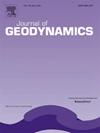2008年汶川7.9级地震后的粘弹性松弛和余震
IF 2.1
3区 地球科学
Q2 GEOCHEMISTRY & GEOPHYSICS
引用次数: 0
摘要
大地震后的震后变形有助于更好地分析岩石圈的流变结构和地球动力学过程。2008年汶川7.9级地震后广泛而持久的震后变形提供了一个独特的机会。本研究构建了青藏高原东部的三维粘弹性有限元模型,并采用Maxwell、Kelvin、Poynting-Thomson和Burgers四种流变模型计算了2008年 Mw7.9汶川地震的震后变形。结果表明,在4种粘弹性模型中,Burgers模型对汶川地震的震后变形拟合效果最好,但在同震破裂带附近仍缺乏早期变形。我们还利用三种不同的余震模型分析了余震对震后变形的影响。结果表明,余震在震后早期变形中起主导作用,特别是在断裂带近场。考虑余震的最优Burgers模型能较好地解释汶川地震的震后变形。松潘—甘孜地块中—下地壳和上地幔的最佳稳态粘度分别为7 × 1018 Pa·s和6 × 1019 Pa·s。本文章由计算机程序翻译,如有差异,请以英文原文为准。
Viscoelastic relaxation and afterslip following the 2008 Mw 7.9 Wenchuan earthquake
Post-seismic deformation following big earthquakes can help to better analyze the rheological structure of the lithosphere and geodynamic processes. The extensive and long-lasting post-seismic deformation following the 2008 Mw7.9 Wenchuan earthquake offers a unique opportunity. This study constructed a three-dimensional (3D) viscoelastic finite element model of the eastern Tibetan Plateau and calculate the post-seismic deformations of the 2008 Mw7.9 Wenchuan earthquake using four rheological models (Maxwell, Kelvin, Poynting-Thomson, and Burgers). The results show that among these four viscoelastic models, the Burgers model provides the best fit to the post-seismic deformation of the Wenchuan earthquake, but there is still a lack of early deformation near the co-seismic rupture zone. We then also analyze the impact of the afterslip on post-seismic deformation using three different afterslip models. The results show that afterslip plays a dominant role in the early post-seismic deformation, especially in the near field of the rupture zone. The optimal Burgers model combined with afterslip can better explain the post-seismic deformation of the Wenchuan earthquake. The optimal steady-state viscosities for the middle-lower crust and upper mantle of the Songpan-Ganzi block are 7 × 1018 Pa·s and 6 × 1019 Pa·s, respectively.
求助全文
通过发布文献求助,成功后即可免费获取论文全文。
去求助
来源期刊

Journal of Geodynamics
地学-地球化学与地球物理
CiteScore
4.60
自引率
0.00%
发文量
21
审稿时长
6-12 weeks
期刊介绍:
The Journal of Geodynamics is an international and interdisciplinary forum for the publication of results and discussions of solid earth research in geodetic, geophysical, geological and geochemical geodynamics, with special emphasis on the large scale processes involved.
 求助内容:
求助内容: 应助结果提醒方式:
应助结果提醒方式:


